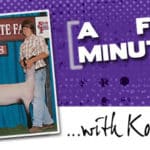
This edition of A Few Minutes is with Tyson Rule, the market lamb judge of tonight’s Sioux Empire Farm Lamb Show. He currently lives in Hawarden, Iowa with his wife, Amber, and their daughter’s Madison and MaKenzie. Tyson owns and operates Rule Sheep Company. Enjoy reading our candid interview with Mr. Tyson Rule!
Why do you take time out of your busy schedule to judge market lamb shows?
I like judging market lamb shows, because it gives me an opportunity to give back to an industry that has done so much for me. I feel I am a better person by being raised thru the Junior Livestock Program and want to make sure as many kids as possible get the same opportunity that I did. That is my top priority! It’s the best seat in the house to get to work with so many different individuals and to see so many good sheep.
What is your background and current involvement in the sheep industry?
My background is a kid who grew up in both the commercial and show side of the sheep industry. My first job was at age 6 unloading semi and trailer loads of lambs at Iowa Lamb Corporation. Since then I have always been involved. My family has been involved in the feeding of commercial lambs since 1955. Currently I manage the finance and production departments for New Horizon Lamb Corporation, a facility management company that houses both commercial and show ewes for producers. I am also in charge of Production and Marketing for my families flock, Rule Sheep Co.
How does your current operation effect what you look for when evaluating sheep?
I like muscle, structural soundness, and stoutness. We expect a lot out of our ewes and lambs in the elements of Northwest Iowa. Light muscled refined structured sheep just can’t compete in the colder temperatures. We are raising sheep first for the show ring and breeding program, but we have a large emphasis on sound production and survivability traits. Sheep that are too straight in their front shoulder, don’t possess enough base width, or have too much set to their back legs do not last long in our operation. I probably am more critical than the average judge on these traits because of this.
What person/people helped to shape your view on what the ideal sheep should posses?
In the show world, I owe a lot of my success to the time I spent evaluating sheep with JB Massey, Ty Allen, Terry Harland, Ritson Urban and Clay Elliott. Each individual had different priorities and liked different types of sheep. This helped me create the type of lamb that I like.
If you had to send one person out to pick out a ram for you who would it be?
I have decided that it is best for me to pick out a ram for myself. With the amount of money that the right ram costs to procure, it is easily worth a drive or a plane ticket to be able to look at the entire pedigree and program behind the individual sheep. For me, it’s is a year round process and doesn’t just take place in the spring or at Sedalia. I still ask a select group of individuals for their opinion constantly about new genetic lines and different ways to cross our current stud ewes and rams to make that next keeper buck lamb.
Where did you attend college?
I attended Iowa State University and Majored in Animal Science with a Minor in Entrepreneurial Finance.
What are your initial sorts when evaluating market lambs?
Structure and Muscle
When you get down to those top end lambs, what separates them for you?
Overall balance. A lamb with less chest and shoulder can get away with less muscle. The heavier muscled a sheep is the more chest and shoulder I feel is acceptable.
What would you consider an acceptable fat range?
I think that fat cover is more of a visual target, than a measureable target for me in the show world. I prefer sheep to have cover on them, but not to a point where it detracts from their overall balance. I’ve spent a lot of time in the coolers and 95% of the show lambs fall into an acceptable range.
One current trend in the market lamb industry is toward an increased bone and foot size. What is your take on this?
I think it is a single trait selection and should be treated accordingly. The positive side is lambs with more bone and foot size tend to be heartier and more durable lambs in our operation. The downside is possibly more birthing challenges. I have assisted in more lambings than anyone else in the show world the last 2 years. My current opinion is that a ewe’s overall size, her feeding thru gestation, and number of lambs she is caring thru pregnancy all have more relevance to birthing problems than foot and bone size today. If we don’t take the single trait to an extreme, I think it makes for a stronger lamb and a more appealing show lamb.
Another place of emphasis has been on analyzing the chest floor in show lambs. What is your input on the importance of this in market lamb evaluation?
Again, this is a single trait selection. As long as the rib shape is round enough, shallow bodied sheep have been just as productive in our operation. The lamb that is hardest to make is the one that is round ribbed, shallow chested, big boned, and heavy muscled. This is what we have been striving for in our operation.
Who are some people that you credit with helping you get to where you are today?
Without my father and grandfather’s involvement and direction in the sheep industry, I wouldn’t be back in the industry today. I’ve been lucky to surround myself with a core group of business professionals that help me in the management, financial, seed stock selection, and marketing rolls of my business. They allow me to think outside the normal production and show realm.
What do you consider an acceptable weight range in market lambs this time of year?
125 pounds to 175 pounds. Lamb is at a premium and there is very little discount for large carcasses. If the lambs can put weight on in an attractive and acceptable manner, then they should be big by this time of year.
What’s your biggest pet peeve in the showring?
Forearm and flank wool
What’s the best market lamb you have ever seen?
Mile High. He was a lamb that Kashen Urban won the National Western Stock Show in 1999 from Bradley and Brian Johnson. The lamb was way ahead of his time.
Who’s the person you must like to sit down and watch judge?
I like to watch Clay Weber and Terry Dumas judge. Clay and I see and prioritize sheep similar and I like the way he communicates to the exhibitors and crowd in an easy to understand manner. Terry was an integral part of moving the show industry back to more dimensional, stouter, heavier muscled sheep in the late 90’s and early 2000’s.
What do you think is the most important issue facing the sheep industry?
Two years ago I would have said competing with low cost imported lambs. Today I would say the decline in total sheep number’s in the United States is the LARGEST problem in commercial industry and will eventually influence the show industry if it isn’t addressed. World protein shortages and our weak dollar have allowed Australian and New Zealand lamb to be supplied to Asia and Europe and have lowered it’s impact on the domestic market. With the US’s ethnic market growing to over one million lambs a year, there is a shortage of quality lambs to fill orders in our current infrastructure. This has been part of the reason for the increase in lamb prices. If we are not careful in supporting the U.S. sheep infrastructure, we may not have an infrastructure to support us at all. Current producers should look at today as a golden opportunity to increase their ewe flock numbers or get other individuals started in the sheep industry and take advantage of the premium for lamb today.
You’ve got one night to go anywhere in the country and watch one band; where is it and who you watching?
My daughters have always wanted to go to New York City to watch Taylor Swift. Not as exciting as Timberland in Vegas, but would be just as enjoyable.
Who is you’re favorite sports team?
Normally it would be the Denver Broncos, but after this year I’ll have to settle for Iowa State’s football program…
What is your favorite place to vacation?
St. Kitts in the Caribean















